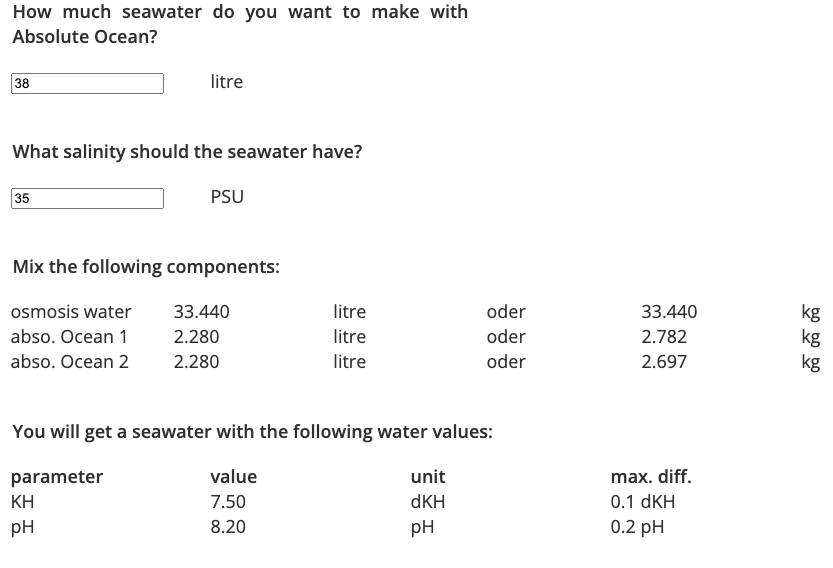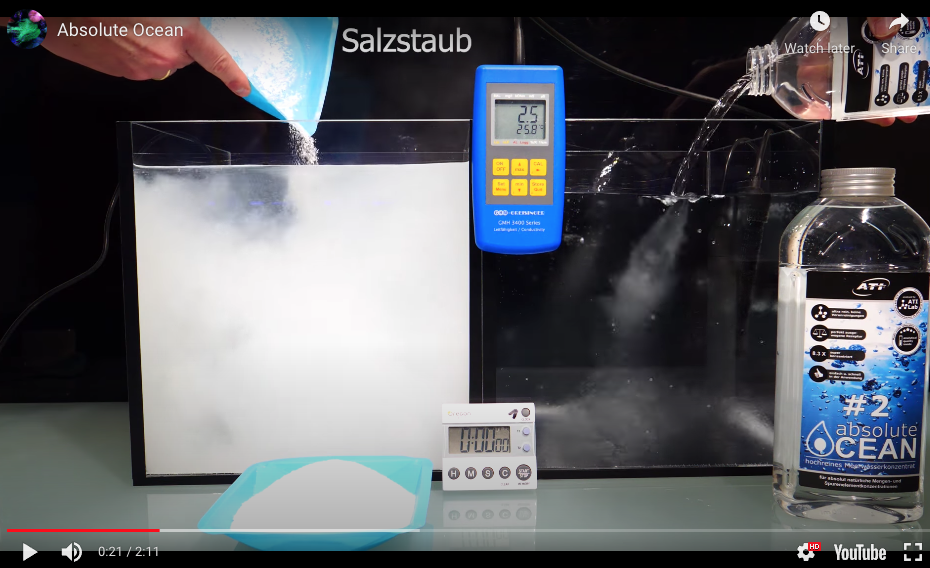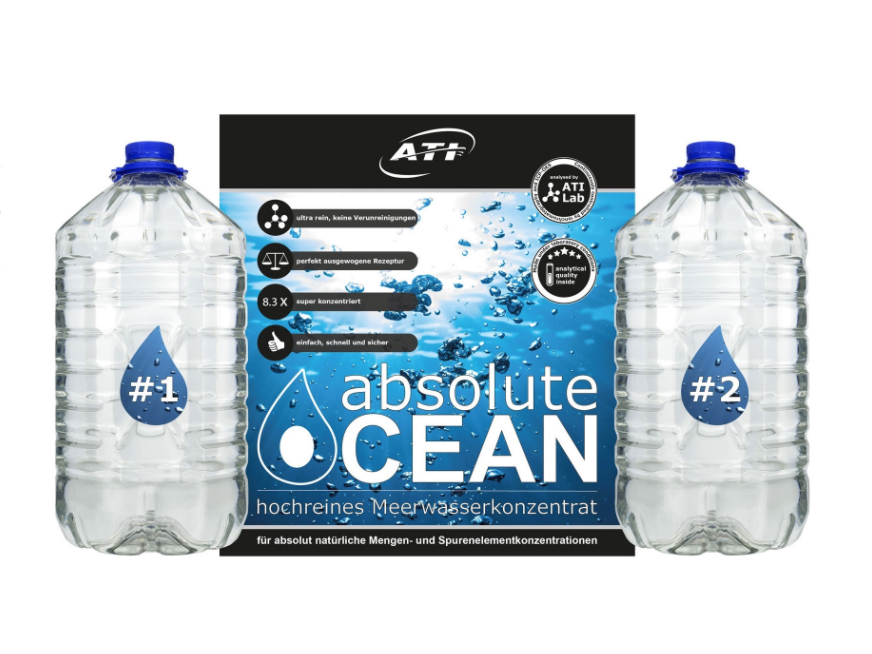Here at Reef Builders we pride ourselves on covering new, important reefkeeping products. But we’ll hold our hands up and admit that this four-year-old product by ATI completely passed us by, and on both sides of the Atlantic!
Readers will be aware of the many ways in which we can purchase and produce saltwater for our aquariums. We can buy a dry salt mix and mix it up ourselves, buy it ready-mixed from our lfs, or even buy natural seawater, but ATI’s Absolute Ocean looks intriguingly different.
Because Absolute Ocean isn’t any of the above, and instead, it’s an 8.3 times liquid concentrate (not a powder,) that you add to RO water to make instant saltwater. Casual onlookers may mistake larger bottles of the clear Absolute solution for ready-mixed saltwater, and smaller bottles for two-part, as each set comes with two identically sized clear bottles, parts 1, and 2. But it’s actually neither and instead, you type how much saltwater you want to make up, into an online calculator, the salinity you require, and the calculator tells you how much Absolute Ocean to add to it to achieve that. Here’s an example.
Let’s say you want to do a 10-gallon water change on your aquarium. First, convert that into liters (38,) and type that into ATI’s online calculator on their website. Next, tell the calculator the salinity that you would like your saltwater to achieve. ATI uses PSU or Practical Salinity Units, but if you’re not familiar with that, it’s the same as PPT, or parts per thousand. And if you’re not familiar with that, look down inside your refractometer and most will display specific gravity on one side (like 1.026,) and the corresponding ppt on the other side, like 35ppt.
Do that and you get an instant result below telling you how much RO to add, as well as the exact, equal amounts of parts 1, and 2, which in this case is 33.44 liters of RO, 2.28 liters of part 1, and 2.28 liters of part 2. Pour the RO into a container, pour in part 1, then part 2, and you’re done. It’s ready to use.

Homogeneity
If you get the amounts exactly right and if you use RO water with zero TDS, the calculator will also give you exact values of the water you’ve just made up, from KH and pH to major elements like calcium and magnesium and trace elements like Iodine. And they’re that sure of that at ATI that they recommend correctly mixed Absolute Ocean as even being suitable as a reference solution.
The reason for this is that versus dry salt, ATI can make up a liquid with exact values and ICP test it to make sure. You then receive that exact liquid and the calculator can then be built based on those values. This can be done with dry salt as well, but lots of factors affect both synthetic and evaporative salt mixes like their moisture content, how well they’re mixed, and settlement and separation of major elements during transport and storage.
This is why some salt manufacturers have had issues since ICP testing has become widely available. You can mix up one batch of salt from one bucket and another from a different bucket of the same brand and they may well ICP test differently. So small boxes or buckets of dry salt, (and using all of them in one go,) are actually a better solution than buying a ton bag like public aquaria use and just taking a bit off the top. It’s an extreme example, but it’s easy to imagine how some elements may not have been mixed thoroughly or may have settled out.
But by making up the base as a liquid back at the factory ATI says the composition can be much more uniform and way more tightly controlled. Even right down to the addition of 1.5 millionths of a gram of Vanadium.
So why aren’t we all using Absolute Ocean? Some are, and some are very happy with it. The retailers we spoke to told us it’s a popular product. But it does still rely on you having RO water to hand meaning you’ll need an RO unit or to travel to buy RO from your lfs. And if you’re going to your lfs to buy Absolute Ocean and RO water you may as well just buy the store’s own ready mixed saltwater. On the flip side is that if you already have an RO unit, you may as well use dry salt as when you get up to large quantities it’s more cost-effective. And the time saving versus waiting for the salt to dissolve doesn’t really matter if you plan ahead.

Price comparison
We carried out a quick price comparison of Absolute Ocean in the UK market, versus natural seawater, versus dry, synthetic salt mix, versus store ready-mix. Two 10 liter (2.6 gals) bottles of Absolute costs £34.00 not including RO and can make up to 170 liters (45 gals,) of saltwater. That’s going to cost you about £200 in the leading brand of prepackaged natural seawater, and it compared very favorably to buying 180 liters ( 48 gals,) worth of synthetic salt, which came in at £33.00.
It compared really well to shop-made saltwater too, which came out at £38.50, so for the thinking reefer, (with an RO unit,) it’s a real contender because of its speed of mixing, purity, and potential, repeatable values.
And we haven’t really seen anything exactly like Absolute Ocean before either. B-Ionic Seawater System makes up seawater using four parts – two parts dry and two parts liquid, but it’s not concentrated like ATI’s, and there’s more of a recipe to follow to make it.
So we can’t pass judgment on the potential of this product as its already been in the reefkeeping global marketplace for four years. We don’t need to guess how successful it’s been either, as its manufacturer, wholesalers, and retailers already know that too. But we can say that regrettably, in that time, it hasn’t changed the way that the majority of people consume saltwater for their aquariums. Despite all its very many positives.



